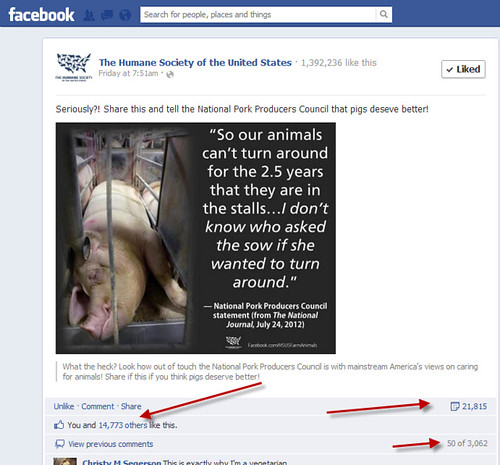
It is a nonprofits dream – to have its advocacy campaign messaging go viral on Facebook or social media channels. And that’s just what happened to the HSUS Farm Animal Protection campaign, an effort to call attention to and reduce the suffering of farm animals raised for eggs, meat, pork, and milk. The above photo and statement was posted on Friday and within 48 hours was shared over 21,000 times, 18,000 likes, and thousands of comments.
Here’s an analysis of what and why it happened from the HSUS’s Director of Emerging Media – Carie Lewis. Her insights are useful to other nonprofits working on integrated advocacy campaigns.
What happened? Did you just post that photo and it went viral by itself?
A representative from the National Pork Producers Council made an insensitive statement about efforts to create more humane standards for pigs on factory farms. We have a campaign against the pork industry’s use of gestation crates going on right now, so we decided to use the quote as an element of the campaign.
Our Farm Animal Protection campaign posted the quote in the form of an image post on their Facebook page (275k fans). They got 18,000 shares in under 48 hours. We could tell the message was resonating, so we decided to share it on our main Facebook page on Friday (1.4m fans).
Observation from Beth: Two best practices here. The HSUS has built its network before they needed it and the listening and paying attention to what is resonating with your network.
How did the National Pork Producers Council react?
Within an hour of HSUS posting it on our main Facebook page, NPPC had completely deleted their Facebook page. They already had blocked the ability to comment on their page. Because we monitor our comments and have an internal policy to respond to everyone that comes to us with a legitimate question or concern on our posts or our wall, we could tell that our fans were contacting NPPC. They were telling us they were sending NPPC private Facebook messages, calling their phone number, and using the contact page on their website. Now, the contact page on NPPC’s website has also been taken down. As of this writing, we’re up to over 37,000 total shares of the graphic and this is the most shared piece of content we’ve ever posted on our page.
What is your takeaway and learning from being on the other side of social media crisis?
I think this is a good example of jumping on an opportunity, like your opposition making an asinine quote, and using it to further a campaign you’re working on. Our Farm Animal Protection campaign came to us right away and said “look at this! We need to use this somehow!” and a Facebook share graphic was born.
We also have a good internal structure when it comes to program Facebook pages – we use the “gatekeeper” model at HSUS where we have one main Facebook page that the social media department manages, and we train the rest of the organization to make it a small part of their jobs (over 100 people.)
Our Farm Animal Protection campaign also did a great job of inserting emotion into the post (“look how out of touch the NPPC is with mainstream America’s views on caring for animals!”) and a call-to-action (“share if you think pigs deserve better!”) which helped the posts’ shareability. When HSUS posted it on their main page, we asked people to “share this and tell the National Pork Producers Council that pigs deserve better!”) How could you not agree with that?
Did the HSUS have to do anything more to get your community to take action?
What struck me about this whole thing was it proved to me that we’ve built an action-driven community on Facebook. Sure, our page has photos of cute animals and engages people in fun conversations about their pets. But when there’s a serious issue at hand, our fans are ready to do what it takes to create real change for animals. We didn’t even ask people to contact NPPC, but they did.
And that’s what I think I’d do differently next time: have an action alert along with other ways people could contact them ready. The #1 thing people ask when we post something like this is “what can I do?”
What advice would you offer to nonprofits are the other side of a social media crisis?
This is a textbook case on what NOT to do in social media when you find yourself in a crisis. NPPC originally blocked comments from their page and when that didn’t work, deleted their page entirely! Social media crises suck. The HSUS has been through quite a few of them. In fact, I think every social media manager needs to go through one. But shutting down only makes it worse; you have to weather the storm.
Here’s more advice from Carie and others about how to handle a social media crisis:
Carie Lewis: Social Media Crisis Tips
The Five Stages of A Social Media Crisis
Mack Collier: Social Media Crisis Management 101
Carie Lewis: Five Free Social Media Tools To Use in A Crisis
Kivi Leroux-Miller: Case Study of Komen for the Cure Social Media Crisis
Infographic: Gone Viral
Infographic: All You Ever Wanted To Know About Viral Marketing
Beth Kanter is a consultant, author, influencer. virtual trainer & nonprofit innovator in digital transformation & workplace wellbeing.
